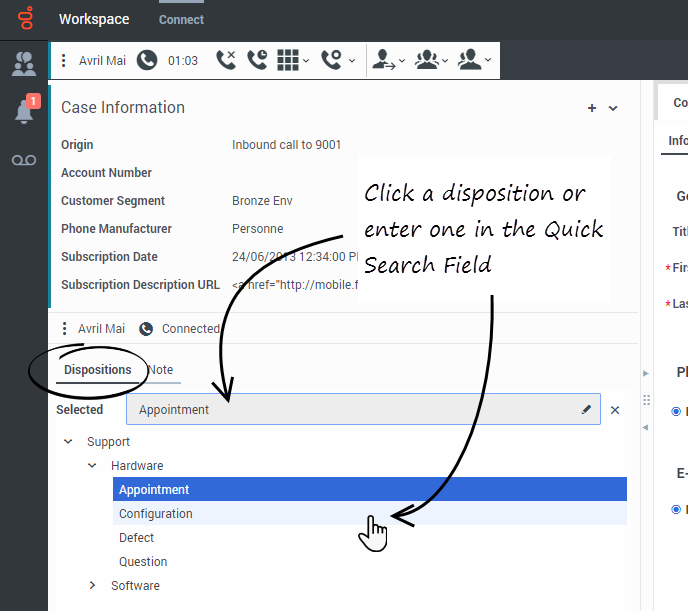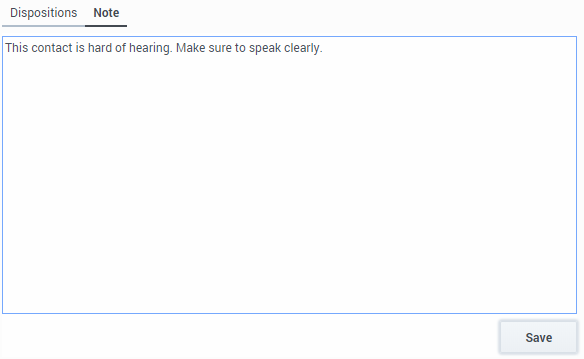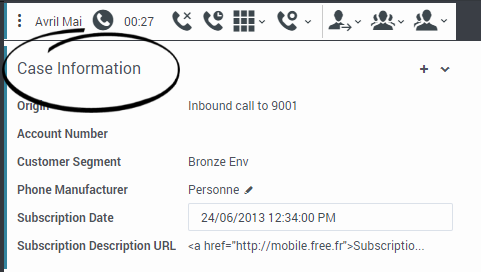Channels
Channels are the different methods that you use to communicate with customers and team members in your contact center. Channels include the voice channel and Digital channels such as chat and email.
Contents
- 1 Channels
- 1.1 Why can't I see all the channels?
- 1.2 What's the difference between a consultation and a conference?
- 1.3 What can I do in the My Channels tab?
- 1.4 What happens to my status when I mark an interaction as Done?
- 1.5 What kinds of customer interactions can I receive?
- 1.6 How do I accept an incoming interaction?
- 1.7 How do I set a disposition code?
- 1.8 How do I add a note to an interaction?
- 1.9 How do I work with case information?
- 1.10 What next?
- 1.11 Top 5 topics
Each channel lets you communicate with your contacts in different ways. You can make and receive phone calls (known as the Voice channel). You can also receive and reply to emails, and interactive live chats.
Why can't I see all the channels?
Depending on your assignment, you might have all, some, or just one of the channels available to you.
What's the difference between a consultation and a conference?
Both activities involve getting help from an agent or supervisor. Consultations let you communicate with a team member privately while handling an interaction. Conferences let someone else from your contact center join the chat or phone call with your contact. If you want to perform a warm transfer or a two-step transfer, click Consult to talk to the consultation target and then click Transfer to transfer the call.
What can I do in the My Channels tab?
Use the My Channels tab to:
- Change your status on a channel
- Log off from a channel
- Turn on/off your Do Not Disturb status (applies to all channels)
- Forward calls that are directed to your extension to another extension
What happens to my status when I mark an interaction as Done?
You might have to mark an interaction as Done ![]() before you can close the interaction view.
before you can close the interaction view.
When you click Mark Done, your status might automatically change from After Call Work to Ready, Not Ready, or some other value, or you might have to manually set your status to Ready, or some other value, after you complete your after call work.
You might be allotted a certain amount of time after each call to perform After Call Work (ACW). If so, your status for the voice channel will be After call work until the time interval has passed, then it might change to Ready or Not Ready. You might also be able to extend your after call work time indefinitely, if a call requires more than the usual amount of after call work.What kinds of customer interactions can I receive?
Depending on your assignment, you might receive interactions through the Voice or Digital channels, such as Chat or Email channels, directly from customers or by way of a consultation, conference, or transfer. Some contact centers are set up to always direct interactions from the same customers to the same agents. If your assignment is set up this way, then you will be able to assist certain customers whenever they call.
How do I accept an incoming interaction?
New calls arrive at your workstation in a pop-up, which lets you decide whether to accept or reject the interaction. If you take no action at all, it will eventually time out and go to the next available agent.
If you're configured for auto-answer, of course, you can't choose to reject an interaction.
Many browsers, such as Google Chrome, Mozilla Firefox, and Microsoft Edge, also display notices to you about interactions and other events. You can manage these notifications through the settings in the browser. See the help for the browser you are using if you want to control browser notifications.
How do I set a disposition code?
You can assign one disposition code to an ongoing or terminated interaction to characterize the outcome of the interaction.
The Disposition Code view is a tab in the Interaction view. It contains a list of choices that you can click to specify the outcome of the interaction. A search field is available to search among the disposition codes.
The Disposition Codes are organized within grouping folders, which cannot be selected as dispositions. These grouping folders do not correspond to business attributes, as they are only textual information.
Select a disposition for the interaction. Once a disposition is selected, the disposition list is hidden and the selected disposition appears in a textbox located at the top of the listing. You can't edit a disposition but you can select a new one.
The complete path to the disposition is available as a tooltip of the disposition name.
Depending on your system configuration:
- You might have to set a disposition code before you click Mark Done.
- You might be able to click Mark Done without a disposition code.
- The Disposition Code view might not be displayed.
How do I add a note to an interaction?
The note is a feature that enables you to enter comments about the current interaction or about a selected interaction. You can view the note in most channels as well as the Contact History view.
How do I work with case information?
The case information view (also called attached data) provides information about an interaction — for example, an account number or type of service.
Some case information might be displayed as the title of the web page, an anchor, or a link. If the link is active, it is displayed as blue text.
To make changes, select the field you want to edit or delete. Fields that you can edit display a pencil icon when you roll your mouse pointer over them.
You can add more fields with ![]() .
.



